
Valle de Tena, as seen from "Pico Pazino". On the left is Sallent de Gállego,
and the very small town towards the right, opposite on the lake, is Lanuza.
The town of Lanuza is itself an interesting locale, with an interesting backstory. In 1977, the townspeople of Lanuza were forced by the government to vacate, because their town would be covered by the water from a new reservoir ("embalse") created to generate electricity. Not willing to give up so easily, the Lanuzans fought a legal battle to secure the movement and reconstruction of their town further up the hill, above the new waterline. From 1992 to 2012, over the course of twenty years, the town, like the mythical phoenix, was born anew and slowly re-inhabited. You can see a list of the original townspeople and the layout of the original town on several commemorative plaques and guides mounted in the church.

The dam which created all the problems for Lanuza, as seen from the town.

When the reservoir waterline is low, as shown here, you can see
the remains of the old highway bridge that led to the old Lanuza.

Photo of newsclipping on Lanuza's rebirth, from Trimbolera's blog.
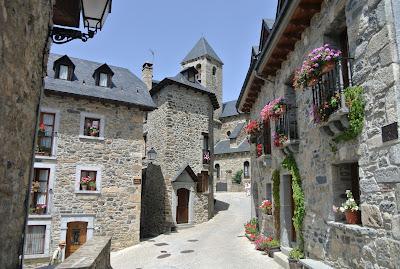
Lanuza follows the classic Pyrenees pueblo style of brick buildings
with black slate roofs. Very picturesque!

Panoramic shot of Lanuza today as seen from the lake shoreline.
We got a special tour of the reconstructed church and school house by a local blogger, El bosque de trimbolera, whose blog, named for a local tree, is one of the best online sources of news and happenings in the Valley. She showered us with local hospitality, even inviting us into her house after the tour for some cheese, bread and wine. (Ah, Spanish hospitality!) Needless to say, after its legal battles and reconstruction, the townspeople have an especially strong pride in keeping up town traditions and unity. Our visit was on the eve of the annual, important August 25th festival, so the older generation was teaching the town kids the important tradition of the "paloteau" musical dance with sticks in the afternoons next to our house. We had just missed the Festival Pirineos Sur, a sizeable international rock music festival which Lanuza, despite its small size, somehow manages to host in July.
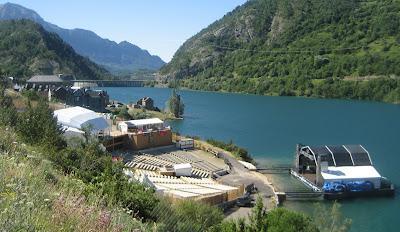
Here you can see the outdoor venue next to Lanuza complete with floating music stage,
where the Pirineos Sur festival takes place. (Photo from Trimbolera's post on it.)
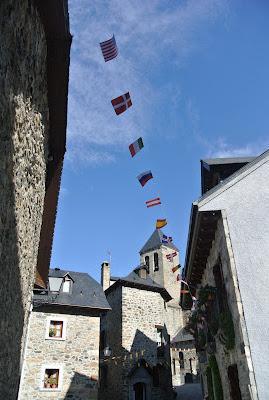
Lanuza town decorated with flags on the eve of its August festival
A great place to eat in Lanuza is the Bar El Frondón. Named for the hillside next to the town, it's a center of activity for the locals, and worth a food stop even if you aren't staying in town. Given that it had wireless internet, I was a regular there and made friends with the bartender. (It was here where I watched the exciting Spain-USA Olympics basketball final.) The sandwiches are truly excellent and, amazingly enough, it has an incredible brownie, a rarity in Spain in my opinion. Plus I got great free insider advice about what to do in the valley. (The cook was a hunter and thus an incredible guide to what are the best trails to hike.) If you are looking for a quality place to stay in the valley for a good price, I highly recommend the Hotel La Casueña, whose name comes from the name of one of the pasture areas of Lanuza that was covered by the lake. (You can read a nice blog entry on this hotel in Spanish here.) They also offer superb, gourmet dinner meals.

Bar El Frondón: the central artery of Lanuza.

One of the best brownies that I've tried in Spain,
a surprise discovery in this humble pueblo bar, El Frondón, Lanuza

The elegant Hotel La Casueña located in Lanuza, by the lake and with mountain views

"Trenza", a traditional pastry to try in Valle de Tena
Of course, Lanuza is tiny. So if you want a slightly livelier more populated option, but one that still has that Pyrenees smalltown vibe, you can always head over to Sallent de Gállego which is a mere 12-minute jog (I know because I ran it) or 20-minute walk from Lanuza, and has a bit more to offer in the way of supermarkets (which is to say it has them) and bakeries. Two good spots to eat here are Restaurante Garmo Blanco, worth the ascent of its formidable staircase to have lovely views and eat exquisite food, and Restaurante Casa Martón, which has a great outdoor patio and serves more homey fare. As I've said before, a key element of "Pueblos con encanto" excursions is to sample the local breads and pastries. Pretty much anything you find at the Panadería La Tahona de Roxanna will be worth it, but the traditional pastry to try in this region is the "trenza" which makes for a tasty breakfast. (If you visit La Cuchara Curiousa's blog post on Valle de Tena, the food photos will have your mouth watering for more.)
The town square of Sallent de Gállego

Though this was where all the action was, including a practice wall for climbing.

The ascent to Restaurante Garmo Blanco

Garmo Blanco is worth the stair-master ascent for the nice rooftop views inside,
including a view of Pico Pazino

For more typical fare, Casa Marión, next to the river, also offers delicious food
What to do in the valley:
You need to spend at least a minimum of a week here to enjoy the valley, and you could easily spend more if you want to try everything it has to offer.
• Skiing & Formigal
What Valle de Tena is probably most famous for is its skiing. Indeed, among the few names I recognized when I first arrived here was Formigal, a well-known ski-resort town with multiple ski slopes during the winter season, and which regularly features in the snow reports in the national weather forecast. As it was off-season in August, I didn't do much there this visit. Unlike many other Valle de Tena towns, Formigal seemed a bit touristy and un-pueblo-like. My mother-in-law described it as "la Cullera de esquí" (Cullera being a typical mass-ified Mediterranean beach town south of Valencia). Still, for snow and ski-slope lovers this is a great destination. My wife and I are eager to get back some winter in the future just to see how the terrain is transformed by the "white stuff".

Formigal ski slopes in peak season (not my photo)

We got a kick out of this advertisement for Lacasitos, the Spanish equivalent of M&Ms.
I can only imagine what this ski lift area must be like at peak season,
because in August it is deserted.

Off-season, this sign next to the Anayet ski lift entrance suddenly becomes significant

The cows take over the ski area, to graze to their heart's delight
• Hiking (or, what to do here when it's not ski season)


The "Alto Gállego" valley lies along one path of the Camino de Santiago, and many
good hiking trails are also officially marked trails of the famous "French Way" pilgrimage.
- - Pico Pazino - -
This trail is an ideal Day One hike to do. Its ascent is a bit of a challenge towards the top, but it gives you a great view of the entire valley, and there is something about arriving to the top of a mountain that just feels very satisfying. A return trip takes about three hours.

The first real landmark on the trail up is this large "chimenea" (chimney).

The trail leading up to the peak.

Formigal and Peña Foratata, and lots of great views of the other valley towns on this trail

The view of the other side of the mountain, from the top of Pico Pazino

Tiny Lanuza, as seen from the top of Pico Pazino
- - O Saldo (from Escarilla) - -
This hike is pretty family-friendly, and the start is right next to the small town Escarilla and thus easy to access. It's key feature is a waterfall (or "el salto" in Spanish and "o saldo" in aragonés) at the end. Again, this is about a two and a half to three hour trip in total.

View of the town Escarilla, as you head up the O Saldo trail

This was probably the most trafficked trail we took, with large groups of families hiking it together

And this is the final destination, the waterfall

I'm not sure if you are actually supposed to swim in it, but it looked like fun

- - Anayet - -
This hike was a bit more challenging, but was probably our favorite trail of all of them... the colorful rocks and the magical glacier lake at the top were magical. And the trail wasn't as heavily trafficked as many of the others, which made it that much more special. Overall, this took us five hours, and we could have spent much more time at the top than we did (due to a thunderstorm).

Red cliff tops towered over this trail, which followed a stream up to its source.

Piles of rocks, the universal trail mark, and the red & white mark for
"Gran Recorridos" marked this valley trail

What made this hike magical was the beautiful blend of red rocks covered with this green moss or something

And pretty mountain streams all around

But the glacier lake plateau and Pico Anayet above it, at the top of the trail,
was breathtaking. This is above 2000 meters high!
- - Ibón de Respomuso - -
While the hike itself was not as spectacular as the Anayet, this trail had one undeniably awesome feature: a bar at the top. After a three-hour ascent you reach an incredibly large lake and the "Refugio de Respomuso" sitting next to it. You can book rooms in the Refugio for overnight stays (something we plan to do next trip), and it has a bar where you can order a fresh pint of San Miguel beer. (I've never tasted better beer in my life! My wife laughed when she saw it was San Miguel's, which has an advertisement campaign based around the idea that you can find it wherever you go.) Expect this trail to take about six hours, there and back (and not including the beer time at the top).

The area at the start of this trail, a 10-minute drive from Sallent de Gállego,
looked like a popular picnic spot for locals.

Cows crossing trails, a common fixture here

Water running across trails, a common fixture here

We weren't so tired as to not appreciate the humor in one of these signs,
which read: "Refugio de Respomuso: S.O.S. y BAR"...
In other words, up at the Refugio (refuge) you could get
both first aid treatment and beer!

Lots of wild rasberries and strawberries starting to appear along the trail,
Three more weeks (~mid September), and there would be plenty of ready-made
trail snacks to be had.

When we got near the top of the trail, we were surprised to see this dam,
which it turns out creates the reservoir for Respomuso.

The Ibón (glacier lake) de Respomuso at 2000+ meters altitude.

The Refugio de Respomuso next to the ibón.

This is what heaven looks like... at least after you've been hiking up
a mountain trail all day and discover this Refugio bar at the end!

Burros (a.k.a. donkeys) hanging out at the Refugio. I was trying to figure out
how they got the beer up here, and my best guess is that these poor guys had to carry it up.
• Teleférico from Panticosa to Rincón del Verde
For those less able to hike, there is another option: the cable car lift ("teleférico") at the town of Panticosa up to the adjacent mountain valleys, Rincón del Verde. The teleférico ride is quite fun, and at the top there are various "miradores" linked by a convenient bus ride. So you can see magnificent views without wearing yourself out.
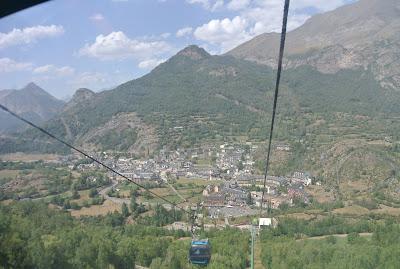
The view of the town Panticosa as you take the cable car lift.

Rincón del Verde is also a ski area, those these ski lifts weren't in use while we were there

The Mirador de Panticosa at the top of the cable car lift.

The Ibón de Asnos, where the bus drops you off at the top.

Cute!

Ascending the short trail around the Ibón de Asnos to reach the final mirador.
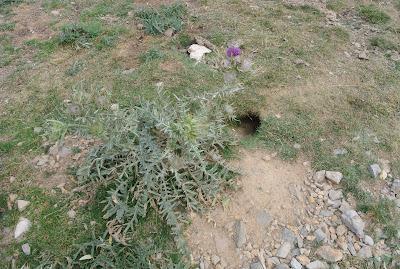
There are apparently groundhogs ("marmotas") in the Pyrenees.
I didn't see any, but saw lots of suspicious holes like this
around the mirador.

The mirador de los valles

Be sure to bring your binoculars on this trip, since there is a lot of bird watching,
especially different kinds of birds of prey in the area!
• Town hopping, Sight-seeing
While Lanuza and Sallent de Gállego have a special place in my heart, the truth is that there are many quaint and beautiful small towns in the valley, and one fun tourist thing to do is hop around and visit them. There is a cute chapel sitting on a hill, "Ermita de Santa Elena," which is worth a look, and the well-off-the-highway town of Hoz de Jaca has a mirador-jaula (lookout cage) which is perched in the edge of a cliff over the valley, and whose open metal framework underfoot will test the courage of anyone with a fear of heights. There are many more towns worth mentioning, but I encourage you to hunt for them yourself.

A little ermita on the side of a hill welcomes you as you arrive to the
Valle de Tena by car.

You can barely make out the green mirador cage (in the center of the photo) sitting on the cliff's edge.
• Outdoors "adventure" tourism
And as with any outdoorsy nature area, Valle de Tena offers ample opportunity for horseback-riding up mountains or through forests and pastureland. And one can go white-water rafting nearby or kayaking on the lakes and rivers in the valley.
Incredible Day Trips:
Don't confine yourself to the Valle de Tena. If you have a week or more here, be sure to consider one or all of these excellent day trips by car.
• Ordesa National Park
About an hour's drive from the Valle de Tena is the Parque Nacional de Ordesa. If you are ever an hour's drive from this national park, you _must_ find time to visit it. I've written much more about it in an earlier post, but just want to reiterate that it is incredible!

• El Castillo de Loarre
About an hour south of the Valle de Tena is a magnificent castle, the Castillo de Loarre, and one of the most complete 11th century castles in Spain. It was the backdrop for Ridley Scott's movie, Kingdom of Heaven (2005), and is worth a day trip to see. While you're there, I recommend dining at the Hospedería de Loarre, which offers quality food.

Picture-perfect Loarre Castle

A good set for a medieval movie about knights

The view of the town, Loarre, from the castle on the hill above

Every time I get a chance, I make sure to order this typical dish, "ternasco",
when anywhere in Aragón where it's from. It's delicious!
I ordered this for lunch at the Hospedería de Loarre.
• Cross the border into France and the French Pyrenees
Lanuza and the Valle de Tena are only minutes away from the French border. (Indeed, you can visit Portalet, a border town which still has the old highway border gates —no longer in use— and go shopping at the many markets there which sell local products from the two adjacent countries.) Just on the other side of France there are a lot more potential day trips, though here I'll only mention a few.
- - Pasturelands and Vallée d'Ossau agrarian goods - -
When we first drove across the border, the road turned a corner and suddenly (a mere 10 minutes into France) the view opened up onto a large, broad valley which could have been the poster for agrarianism, with herds of cows, horses, and goats roaming free at the foot of giant hills and mountains. We decided to return another day to park and stroll around. One quickly discovers that hopping into France's Vallée d'Ossau to buy certain goods — artesanal honeys, mustards, and jams — is a big local industry, one which my belly and I both recommend.




Cross the border and you see tons of signs advertising "Fromage" and "Greuil",
one of many typical agrarian foods to be found in the French valley.
- - Le Petit Train d'Artouste - -
If you have kids with you, then everyone I talked to recommended this ride. The Petit Train d'Artouste boasts being the highest train in Europe in altitude.

- - Pau, and other quaint French Pyrenees towns - -
Cross the border and you will immediately see that French Pyrenees towns look very different from Spanish Pyrenees towns. By all accounts, one of the most beautiful to visit is Pau. You can take advantage of the excursion to dine here on the French cuisine.

I will miss you Valle de Tena... Lanuza, Pico Pazino and all. But I promise I'll be back again soon!

Crescent moon over the Pico Pazino, seen from Sallent de Gállego

Vivid, stormy sunset behind Formigal and the Peña Foratata, as seen from Lanuza
